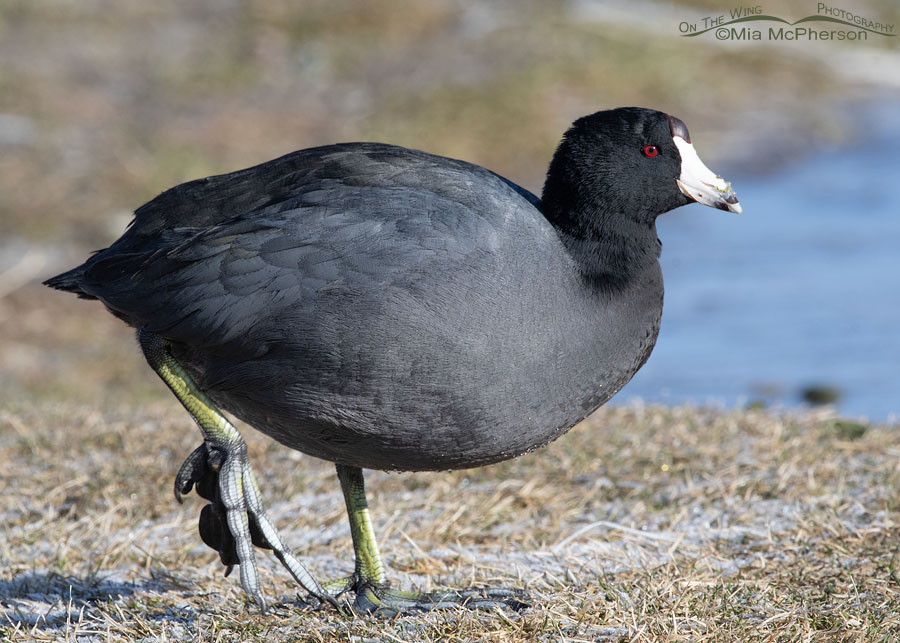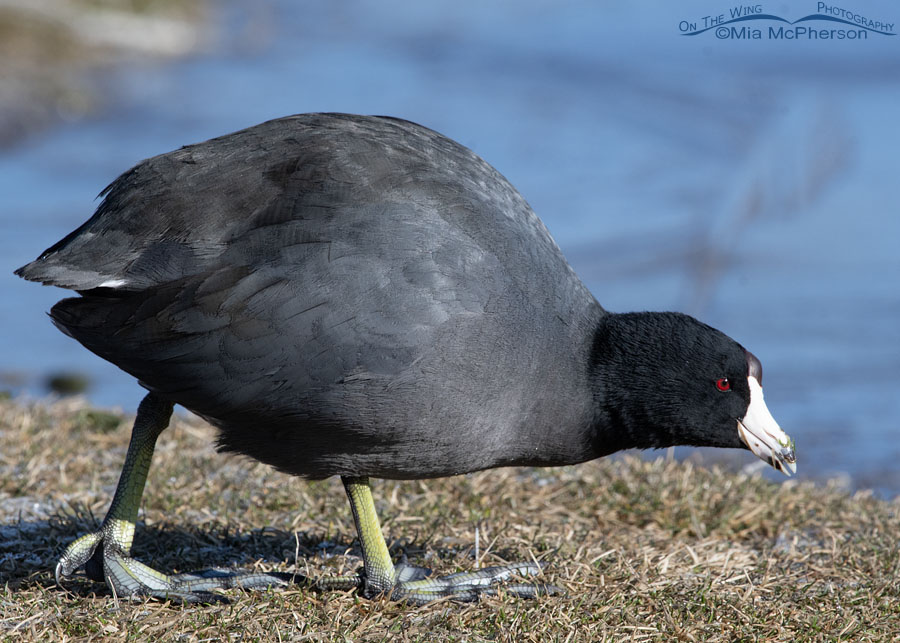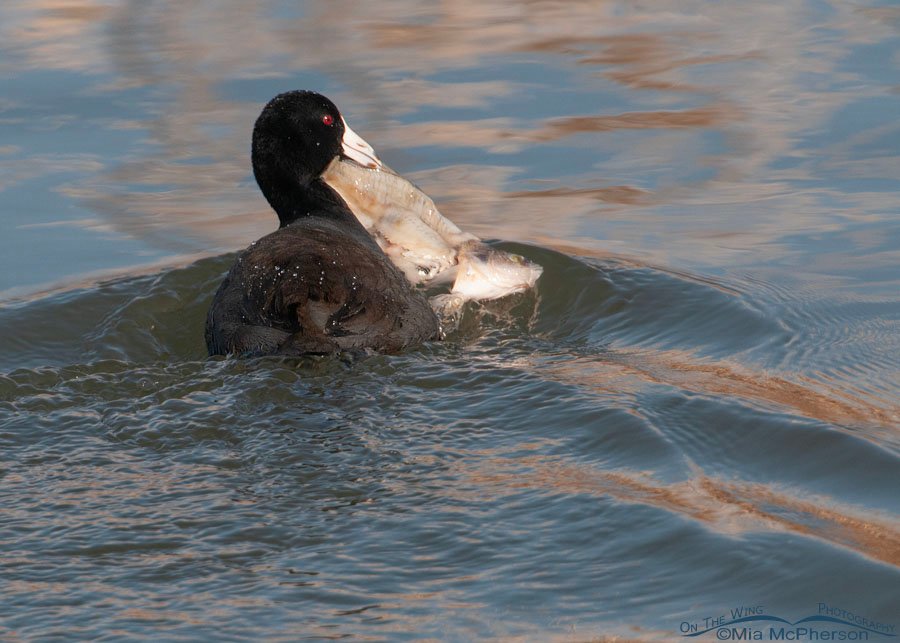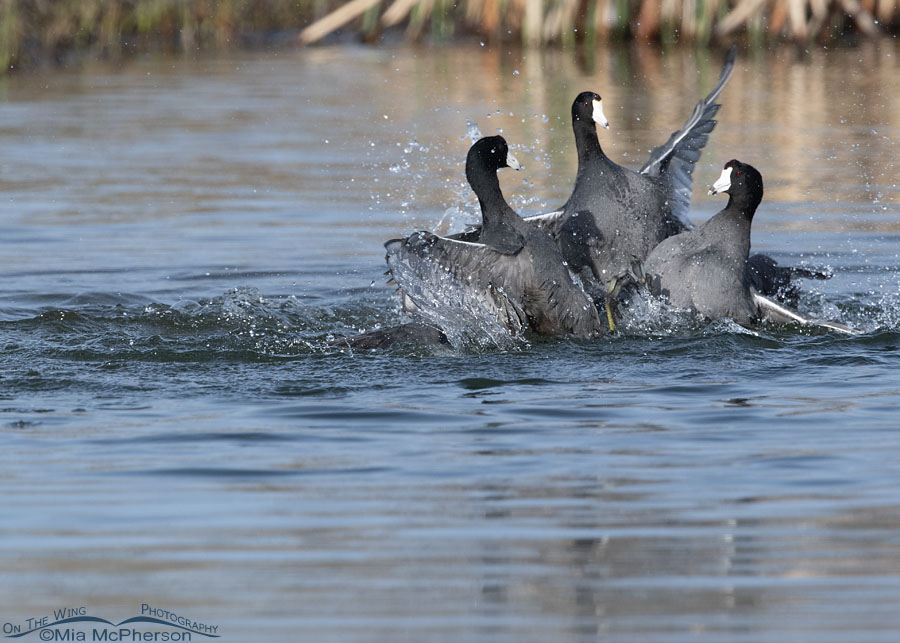Because it was a bright, sunny day yesterday morning, I went down to my local ponds. I photographed an American Coot munching on frosty grass near one of them.
 Urban American Coot in winter – Nikon D500, f11, tripod mounted, 1/500, ISO 500, Nikkor 500mm VR with 1.4x TC, natural light
Urban American Coot in winter – Nikon D500, f11, tripod mounted, 1/500, ISO 500, Nikkor 500mm VR with 1.4x TC, natural light
The coot was fairly close to where I was standing behind my tripod. The photos I took, and that I am sharing today, were pretty much full frame. I cropped a tiny bit, so they are in a 7×5 format, that’s all.
What I liked about this coot image from yesterday was how visible the coot’s large, lobed, green, and gray feet were, especially the coot’s right foot because it is out in the open and not in the grass.
 Urban American Coot feeding on grass – Nikon D500, f11, tripod mounted, 1/640, ISO 500, Nikkor 500mm VR with 1.4x TC, natural light
Urban American Coot feeding on grass – Nikon D500, f11, tripod mounted, 1/640, ISO 500, Nikkor 500mm VR with 1.4x TC, natural light
And I liked the pose of the coot in this second image. I see coots in the water more frequently than I do on solid ground, so when they are feeding or walking around on the ground, I like to take photos of them.
Whenever American Coots come into view, I’m always eager to take their photos, regardless of what they’re doing.
Whether they are fighting, chasing each other, searching for food, resting, preening, or bathing, American Coots attract my attention. They are interesting subjects for me.
Do Coots Behave Different In Other Geographic Locations?
 American Coot with a large fish – Nikon D300, f7.1, 1/1250, ISO 500, Nikkor 200-400mm VR with 1.4x TC at 400mm, natural light
American Coot with a large fish – Nikon D300, f7.1, 1/1250, ISO 500, Nikkor 200-400mm VR with 1.4x TC at 400mm, natural light
My dear friend and wildlife photographer, Steve Creek, who lives in Arkansas, and I have talked extensively about the behavior of the American Coots I photograph in Utah. Steve also heads to Oklahoma frequently to photograph birds and wildlife.
In Utah, I take a lot of action photos of this species: feeding, fighting, chasing each other, and more.
When Steve saw my photo of this American Coot, he was puzzled, because he’d never seen a coot with fish as prey. In fact, Steve has only seen them feeding on vegetation in Arkansas and Oklahoma.
 Urban American Coots in a fight – Nikon D500, f7.1, tripod mounted, 1/1600, ISO 6400, Nikkor 500mm VR with 1.4x TC, natural light
Urban American Coots in a fight – Nikon D500, f7.1, tripod mounted, 1/1600, ISO 6400, Nikkor 500mm VR with 1.4x TC, natural light
So, both Steve and I are curious: do American Coots behave differently in various geographic locations? How do the coots where you live behave?
I’ve seen fighting, chasing, and aggressive coots in Utah, Florida, Montana, Wyoming, Virginia, and Idaho.
And speaking of coot behavior, I saw a pair of American Coots mating yesterday morning, in February in Utah. It seems a bit too early for that, but it has been so warm and spring-like here. The coots might be confused. I’m used to seeing geese and ducks mating this early in the year, but not coots.
Life is good.
Mia
Click here to view more of my American Coot photos plus facts and information about this species.


Finally! I’m thrilled to see there is a creature on earth with feet that look worse than mine. All the pics are great but the top pic steals the scene. The eye contact is wonderful. Thanks Mia.
In our part of San Diego we have Lake Miramar nearby [it’s actually a reservoir] and about 20 billion coots live there. They are fun to watch but massively spoiled. As soon as you reach the shoreline a stampede of coots come running up looking for treats. The managers of the Lake don’t seem to mind because we see people feeding the coots all the time.
We see a great many, here in Oakland, CA, in brackish water and in the SF Bay. I haven’t seen them nest here, but in late winter and early spring they get more and more aggressive, which I have thought must be related to mating season’s approach.
Love coot antics! The SoCal ones I watch are fairly calm — until they aren’t. More than once, I’ve seen groups of them go after ducks (or other coots) that have come to close to their “secret coot meeting.”
Your photos are so unique and especially like the one of the 3 of them having a squabble.